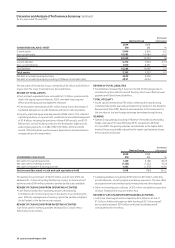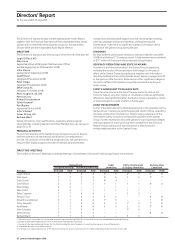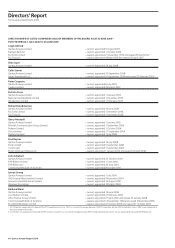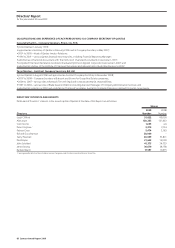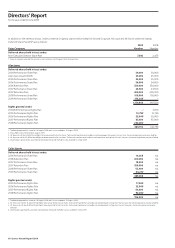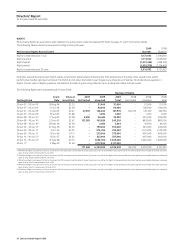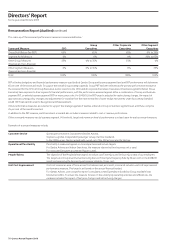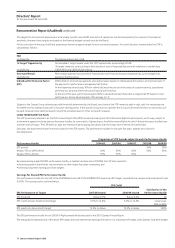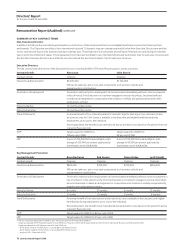Qantas 2009 Annual Report Download - page 71
Download and view the complete annual report
Please find page 71 of the 2009 Qantas annual report below. You can navigate through the pages in the report by either clicking on the pages listed below, or by using the keyword search tool below to find specific information within the annual report.
69 Qantas Annual Report 2009
FIXED ANNUAL REMUNERATION
Executives
FAR is a guaranteed salary level. Cash FAR, as disclosed in the remuneration tables, excludes salary sacrifice components such as motor vehicles and
superannuation.
FAR is set with reference to market data, reflecting the scope of the role and the performance of the person in the role. FAR is reviewed annually and
overall reflects a middle-of-the-market approach, as compared to similar comparative roles within Australia, with particular reference to large public
companies for the most senior roles.
With the exception of increases linked to promotions and changes in roles, there has been a general freeze in Executive FAR since May 2008.
Non-Executive Directors
Non-Executive Director FAR is determined within an aggregate Directors’ fee pool limit. An annual total pool of $2.5 million was approved by shareholders
at the 2004 AGM. FAR comprises Director’s fees, Committee fees and superannuation. In addition to FAR, Non-Executive Directors are paid a travel
allowance when travelling on international flights of greater than six hours to attend Board and Committee Meetings.
Non-Executive Directors’ remuneration reflects the responsibilities of Non-Executive Directors and is determined based on the advice of independent
remuneration consultants.
Non-Executive Directors do not receive any performance related remuneration.
The Non-Executive Director fee structure (including superannuation) is disclosed in the table below and has not been revised since 2007:
Board Committees1
Chairman2 Member Chairman Member
Annual fees $544,000 $136,000 $54,400 $27,200
1. Committees include the Audit Committee, Remuneration Committee, Nominations Committee and Safety, Environment & Security Committee.
2. The Chairman does not receive any additional fees for serving on, or chairing, any Board Committee.
SHORT TERM INCENTIVE PLAN
The STIP was introduced on 1 July 2009 for the 2009/10 performance year and replaces both the PCP and PSP. It was approved by the Board at its June
2009 Meeting following an extensive review of the Remuneration Framework, which takes into consideration the views of key stakeholders on the
structure and operation of the incentive plans at Qantas.
A key principle of the STIP is that performance is assessed against an appropriate balance of Group and business segment measures and both financial and
non-financial measures. Accordingly, the performance scorecard for corporate roles is based on Qantas Group financial and non-financial measures. The
performance scorecard for business segment roles is based on a mix of both Qantas Group measures and tailored business segment measures. This is a key
change from prior years where the performance hurdles under the PCP and PSP focussed on Group measures. The change was introduced to promote
greater accountability for business segment results.
A minimum of one third of any award under this plan will be deferred into Qantas shares with a two year vesting period.
Directors’ Report
for the year ended 30 June 2009
Remuneration Report (Audited) continued
Year 0
•GroupandSegmentScorecard
targets set by the Board.
•SetforeachExecutive:
–‘attarget’reward;and
– individual Performance Plans
(including KPIs).
Year 1
•Attheconclusionoftheyear,the
Board assesses performance
against Group and Segment
Scorecard targets.
•Individualperformancereviews
completed.
•STIPrewarddetermined,with:
– between one third and 100 per
cent of any reward deferred into
Qantasshares;and
– the remaining reward payable
immediately in cash.
Year 3
•AnySharesawardedattheendof
year 1 vest at the end of year 3.
•Sharesmaythenbesold,subject
to compliance with the employee
Share Trading Policy.
Year 2
•Sharesaresubjecttoatwoyear
vesting period.
•IfanExecutiveterminates
employment in years 2 or 3 and
is a Good Leaver (e.g.
retirement, redundancy,
death or total and permanent
disablement), then shares are
released, otherwise shares are
forfeited on termination.
The following table outlines the operation of the STIP:


